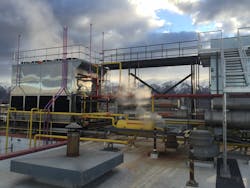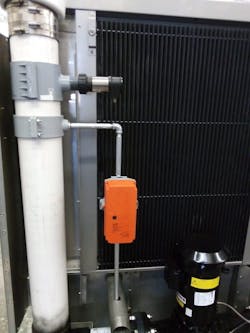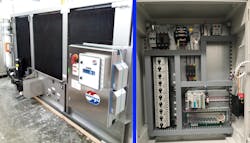Case Study: Open controller speeds time to market
As a worldwide original equipment manufacturer (OEM) of evaporative condensers, Güntner is tasked with designing and delivering systems for a wide range of industries, users and locations. Reliable long-term performance of these large-scale heat exchangers is crucial to increase uptime. End users are also looking for ways to improve cooling water quality, save water, minimize chemical usage and obtain operational data for analysis.
To satisfy these requirements, Güntner has developed in-house microcontroller and printed circuit board design capabilities. These dedicated platforms enable the company to create cost-effective and dependable automation systems for their core products. However, these embedded designs can add time to the development cycle when new or specialized options are needed.
When a need arose in the North America and Latin America regions to add new functionality to heat exchanger systems, the company considered whether it was best to stick with their traditional embedded automation approach or use commercial off-the-shelf (COTS) programmable logic controllers (PLCs). During this investigation process, they discovered a product line of industrial controllers based on open-source concepts, which provided the best aspects of both approaches. This article explains why this type of open automation controller provided the ideal platform to help the company quickly add new functionality to its proven systems.
Mission-specific design
Heat exchangers are used to transfer heat between two different media — such as air-to-air, liquid-to-liquid or liquid-to-air — as needed for heating and cooling other operational systems. The simplest devices are passive, but more advanced systems incorporate pumps, fans, valves and sensors (see Figure 1).
Güntner has always focused on driving efficiencies, from economic to environmental, to its products. As a company pioneering the hybrid application of cooling with both air and water, they found it critical to develop application-specific technologies to create value for their customers. To do this effectively, the company developed its own industrial control systems to support these goals.
Two examples are the Güntner motor management (GMM) and hydro management (GHM) controls — for reducing power and water consumption, respectively. Other advanced features include:
- Low-capacity motor management: Regulates each fan independently, even in reverse, to provide proper cooling.
- Ice-break mode: This patented logic increasingly applies torque to the clockwise and counterclockwise direction to break ice and debris from the fans.
- Efficiency mode: Considers actual costs of water and electricity to determine whether to increase fan speed or water cooling.
These and other advanced features have been added over the years based on customer needs and requests.
Adding a new feature
Continuing along the path of delivering high-performance solutions, the company determined that its customers and the market were calling for a new conductivity control option. The water used in cooling systems builds up contaminants, which negatively affect equipment life and operation. Adding treatment chemicals and using fresh water to purge out poor quality water are two approaches to the problem. However, many operations err on the side of using too much chemical or by running continuous and wasteful manual purges.
The solution needed to be developed and offered to customers in a two-month timeframe, which was not feasible with the company’s typical staff availability. The standard company approach of developing automation solutions using its internal group and customized solutions was proven and reliable, but there was a downside. Development could take a longer time overall than integrating COTS hardware and software.
Other requirements exacerbated this issue. System status would need to be available to the customer via analog and digital I/O, with the plan to evolve into implementing industrial communication protocols and even remote internet of things (IoT) connectivity. Along with this functionality, a basic user interface was needed to support configuration changes to the controller.
To meet all the requirements, a different approach was necessary.
Expanding options
After determining its conventional automation approach and the rollout time involved was not a fit for the project timing, the design team shifted and considered how it could execute the project using industry-standard PLCs. PLCs certainly offered the right industrial form factor, but they had many extraneous functions not needed for the application, and designers had some reservations about using this technology. Commercial PLC platforms also involved higher costs than products developed internally.
During the search, the team discovered the AutomationDirect ProductivityOpen controller. This product is a variation of traditional PLCs, providing many advantages to support the teams’ design goals, while meeting an acceptable price point.
Industrial controllers, like conventional PLCs or the microcontrollers developed by Güntner, are robust operational technology (OT) platforms for providing mission-critical automation. However, their programming, computing and communication abilities come with some limitations compared with modern IT-based platforms like PCs, which use more open programming methods.
In fact, there are many inexpensive commercially available microcontroller platforms like Arduinos, which could technically be used for industrial automation. However, these consumer-grade devices are not built to withstand the rigors of industrial installations, and they require significant adaptation to connect with typical wired field signals.
What drew the team to the ProductivityOpen controller was how it merged modern IT-type programming and connectivity into a compact OT-type form factor (see Figure 3). ProductivityOpen is basically an open software configurable controller. However, the Arduino-compatible CPU is truly industrial-grade and physically packaged like a PLC to withstand harsh conditions.
The ProductivityOpen connects with readily available industrial-grade I/O modules offering all the necessary characteristics for connection with standard industrial control elements using field signals for 4-20 mA analog control, 24 VDC discrete I/O and relay outputs. The platform carries UL and CE approvals so users can integrate it with any equipment they develop.
Standard consumer-centric Arduino controllers offer hardware expandability using “shields” to add networking, wireless, I/O signaling and other features. The ProductivityOpen maintains this ability to use generic shields, and there are also industrially hardened add-on shields to provide more reliable functionality. In fact, users can develop do-it-yourself shields created from the component level up, which can address nearly any issue needing a custom solution.
Because the controller is Arduino-based, developers can use open-source programming techniques and a variety of languages. They are not constrained to the specific languages and features offered by a PLC-based platform, so users are free to create solutions to meet any need.
Once technical and development concerns had been evaluated, the remaining commercial hurdle was easily cleared because the ProductivityOpen platform is low cost. The team would realize the same types of benefits as its normal embedded methods, but it could proceed more quickly by choosing a COTS platform based on open concepts. While this approach was different than Güntner’s standard, the team felt confident this solution had all the elements needed to be successful.
Getting started
The team already had open source experience and was able to immediately apply its skills and familiarity with C++ and Arduinos to begin development. ProductivityOpen also supports standard “sketches,” which is the term used for code run by Arduinos, and it is supplied with a graphical programming interface called ProductivityBlocks, which simplifies many common tasks.
As additional functionality was required, the team was able to access online developer communities to obtain free and open sketches, which it could leverage to build out any function it needed. The premise behind the “open” nature of this controller is enabling developers to create and customize the features as needed.
Created code is not typically proprietary, meaning it can be shared freely and made available to be viewed and reused by others. The developer community is a setting where peers can review, audit and improve the underlying code. This differentiator provides new users access to features normally taking an extended amount of time to develop.
Comprehensive documentation and factory hardware support helped the team to get started quickly. For some detailed software questions, it was possible to post in the community forum and get quick and informative feedback. To further the collaborative efforts, the team was able to post some of its results to also help the community.
In addition to the functional control logic, users and technicians would need some ability to monitor operation and adjust settings. For the user interface, a basic USB-based terminal access was more than adequate for the sporadic use required by technicians, and it was effectively free to provide this connectivity, with no specialized software required. This allowed for field set point changes and adjustments without requiring the software to be reloaded.
Although not required for the initial design, the team was already thinking of new features that could be delivered using this flexible platform.
Flexibility for the future
Güntner has found significant customer interest for the new conductivity control option. With the open control platform proven in operation, Güntner has more flexibility than ever to provide this option and other future upgrades and enhancements. Features such as retrievable local data logging, remote monitoring and IoT connectivity are just a few of the ideas the team is thinking about implementing. Many of these updates may be added in the field using the same tools already in place for the startup and maintenance of this option.
Open control provides a unique flexibility and developmental responsiveness, enabling Güntner to provide extended value and a path toward solutions supporting the needs of end users.
As OEMs everywhere face challenges requiring more to be done with less, the ProductivityOpen platform provides a cost-effective way to deliver reliable automation quickly using modern development concepts. For Güntner, open control enabled rapid delivery of a successful solution and provides long-term features and capabilities that will help enhance the product line.
Zachary Wernlund is the smart solutions manager for Güntner in the North and Latin American markets, working as a global team member with the development team in Germany. He is currently leading the application of innovative IIoT technologies to the Güntner product line globally. Wernlund received his master’s in electrical engineering from North Carolina State University with a focus on the development of electric power systems and renewable energy.



